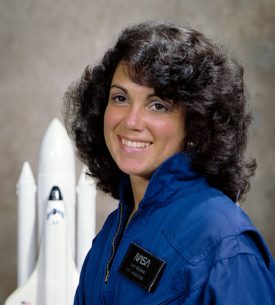- Mechanical
- Posts
- How ancient forging still shapes modern engineering
How ancient forging still shapes modern engineering
Mechanical engineering updates, movie recommendations, and our Engineer of the Month is...

Welcome back! This month’s Mechanical newsletter explores how ancient forging still shapes modern engineering, how membranes make aluminum recycling cleaner, and what rodent silk can teach us about strength.
Plus, we spotlight Judith Resnik, the forever young NASA legend. Take a peek at the world’s most advanced warship, and recommend some offbeat space movies that deserve your attention.
🚨Aerospace: From commercial spaceflight to deep space exploration, our newsletter propels your aerospace career on the first Friday of every month. Click here to subscribe now.

Did a friend forward this e-mail to you? Subscribe here
INDUSTRY UPDATES
US unveils world’s most advanced warship with 1,150-mile range, 44-ton payload
This autonomous vessel has a top speed of more than 50 knots and a range of 1,000 nautical miles.
Student-built HydraJet from recycled parts swims over water with air power
A sleek, agile hydroplane that skims the water, with the help of a top-mounted 70-mm Electric Ducted Fan (EDF).
US: World’s largest six-lane wildlife crossing takes shape in California
A $92 million, ambitious five to six lane wildlife crossing bridge project, which started in 2022, will be completed in 2026.
Biofuel could become hydrogen carrier
An international team of scientists has developed a novel method for storing and releasing hydrogen that involves lignin-based jet fuel
Spider silk stretches for strength
Cutting-edge computational study reveals why spider silk becomes stronger once stretched.
SPOTLIGHT
Source: Pexels
Forging Ahead – How an Age-Old Process Still Powers Modern Engineering
Forging is an ancient yet remarkably versatile metalworking process, dating back to Mesopotamia around 4000 BC. It shapes metals through hammering, pressing, or rolling, typically after heating them to temperatures where they become malleable.
Historically, blacksmiths utilized this method to craft tools, weapons, and agricultural implements. Modern forging, however, has evolved significantly, incorporating electrically powered presses and advanced tooling to achieve high precision, strength, and durability in manufactured parts.
Today, a variety of metals such as steel, aluminum, brass, copper, titanium, and stainless steel are commonly forged, as these metals withstand compressive forces without becoming brittle. However, materials like cast iron or high-carbon steel, prone to cracking under impact, are unsuitable. Forging provides critical advantages, including improved grain structure, superior mechanical strength, and absence of defects like porosity and cracks.
The forging process involves several key stages. Initially, dies—special molds designed for shaping—are prepared. Metal billets or ingots are then heated in furnaces to precise temperatures, often between 850°C and 1150°C for steel, making them easily deformable. Next, the heated metal is pressed or hammered into the desired shape, possibly requiring multiple passes and reheating to reach exact dimensions.
Subsequently, components undergo heat treatment such as annealing or tempering to refine mechanical properties, followed by controlled cooling to optimize strength. Final finishing steps, including machining and surface treatments, prepare the parts for industrial use.
Forging methods are classified by temperature into hot, warm, or cold forging. Hot forging, performed above the metal’s recrystallization temperature, requires lower force but yields less precision and a rougher finish. Warm forging, conducted at intermediate temperatures, provides improved precision and smoother surfaces, whereas cold forging at room temperature offers high dimensional accuracy but demands significant compressive force.
Different specialized forging techniques, like drop forging (using hammer impacts), press forging (continuous pressure), upset forging (expanding bar ends), roll forging (using opposing rollers), and precision forging (near-net shapes at controlled temperatures), cater to diverse industrial needs.
Due to its reliability and strength advantages, forging remains essential across critical sectors, including aerospace, automotive, and oil and gas, for components like gears, crankshafts, valves, and bearings, continually advancing through innovative materials and simulation technologies.
MechTech Innovations
Optimized recycling method recovers aluminum from smelting waste
Aluminum smelting plants often discard valuable aluminum along with contaminated cryolite, a practice that drives up costs and environmental waste. To address this, MIT researchers, in collaboration with Japanese manufacturer Nitto Denko, have developed an innovative nanofiltration membrane designed to recycle aluminum from spent cryolite efficiently.
The membrane uses a thin, positively charged coating to selectively capture aluminum ions, effectively blocking 99.7% of aluminum while allowing contaminants like sodium, lithium, and potassium ions to pass through.
The filtration method splits the waste stream into two solutions—one easily disposable, and another rich in recyclable aluminum ions. Lab tests demonstrated the membrane’s remarkable durability and chemical resistance, performing consistently after prolonged exposure to harsh acidic conditions.
The researchers have also integrated an energy recovery system, utilizing a high-pressure pump and a pressure exchanger, slashing energy consumption by up to 80%. The spiral-wound configuration of the membrane further ensures compactness, cost-effectiveness, and reduced fouling.
As global aluminum demand continues to soar, this innovative recycling technology offers a sustainable, energy-efficient solution for aluminum production, reducing both environmental impact and operational costs.
 | Engineer of the Month 1949 - 1986Judith Resnik Electrical engineer | NASA Astronaut |
Judith Arlene Resnik (1949–1986) was a pioneering American electrical and biomedical engineer, pilot, and NASA astronaut. Born in Akron, Ohio, she excelled academically, becoming the only woman in the U.S. to achieve a perfect SAT score in her year. After earning a Ph.D. in electrical engineering, she joined NASA in 1978 and became the second American woman and the first Jewish woman in space aboard Space Shuttle Discovery in 1984. Resnik contributed to shuttle software, remote manipulator systems, and satellite deployment. She tragically died in the 1986 Challenger disaster. Honored with numerous memorials, awards, and celestial namesakes, she remains a trailblazer for women in STEM and space exploration. | |
MOVIE RECOMMENDATIONS
Coherence (2013)
A dinner party turns surreal when a cosmic anomaly creates parallel realities. Smart, low-budget sci-fi that plays with quantum mechanics and identity.
Europa Report (2013)
A realistic, found-footage-style space mission to Jupiter’s moon Europa uncovers potential alien life. A quiet, scientifically grounded thriller.
Love (2011)
An astronaut stranded on the ISS grapples with isolation and the nature of human connection. Produced by rock band Angels & Airwaves, it’s philosophical and haunting.
The Vast of Night (2019)
Set in 1950s New Mexico, a switchboard operator and a DJ uncover a possible extraterrestrial signal. Slow-burn suspense meets retro sci-fi charm.
Ikarie XB-1 (1963)
This Czech gem predates 2001: A Space Odyssey, exploring a deep-space mission and psychological strain with eerie Cold War undertones.
Additional Reads
🚨 The Blueprint: IE's daily engineering, science & tech bulletin.
⚙️ Mechanical:Explore the wonders of mechanical engineering.
🛩️ Aerospace: The latest on propulsion, satellites, aeronautics, and more.
🧠 AI Logs: Insights into the intricacies and developments within the realm of artificial intelligence.
🎬 IE Originals:Weekly round-up of our best science, tech & engineering videos.
🟩 Sustainability: Uncover green innovations and the latest trends shaping a sustainable future for the tech industry.
⚡Electrical: From AI to smart grids, our newsletter energizes you on emerging tech.
🎓 IE Academy: Master your field and take your career to the next level with IE Academy
Want to share your feedback? [email protected]









